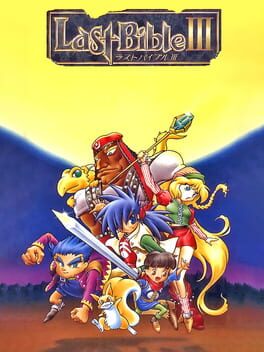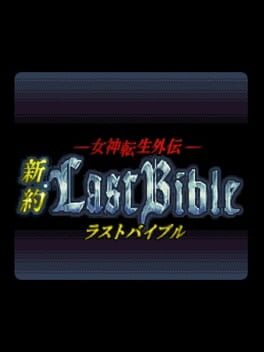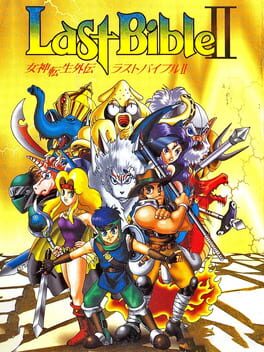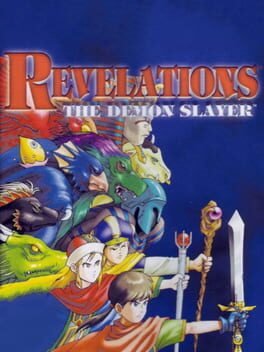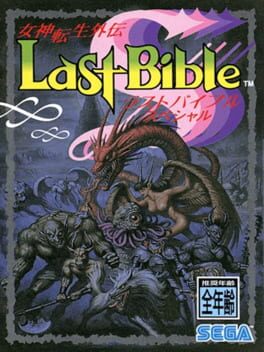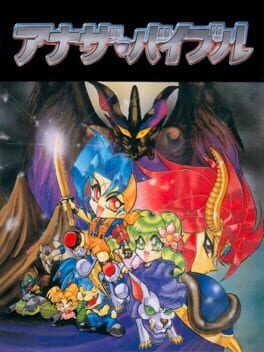

Last Bible III is the final entry in the Last Bible trilogy. Unlike the first two games, this game was not released on a portable system. The game follows Ciel, a boy who leaves his home town to travel to go on a journey.
Also in series
Reviews View More
After playing the first two Last Bible games a couple years ago, I had been meaning to get around to their Super Famicom successor ever since then. But then I got kinda burned out on SMT and monster collecting games, and I got super addicted to Super Robot Wars games for nearly a year straight, so that didn’t end up happening until now XD. Still on my RPG kick, I decided to finally complete the old LB trilogy, and I’m really glad I did! It took me about 40 or so hours to beat the game in Japanese on emulated hardware.
The story of Last Bible 3 follows a young boy named Ciel, growing up in the tiny secluded village of Raga. He has his best friends Mochowa and Aaron, and he has his little brother Rudy, and they live a relatively normal life, going to school and playing together. But then one day, a few wild things happen in quick succession. They stumble across some ancient ruins, they find and revive an ancient warrior android named Duu, they hatch the egg of a baby Tetradragon, and they learn the government is going to ban the use of Gaia (the sort of magic/life force thing they practice at school). No sooner have their teachers left to petition the Senate to reverse their decision when a government-sent drop ship full of troops come to wipe the village out in their efforts to kill Ciel’s father, Glen. Fighting off the attack, the villagers all decide to flee the village rather than stay, and that’s only the too-short summary of the beginning of a much wider and deeper story than I would’ve ever expected on the Super Famicom.
The writing in Last Bible 3 genuinely blew me away in just how well it’s done, and it really feels like a video game version of a fantasy OVA from the period. Not only are the character interactions very funny and well done, but god damn does this game have a political narrative I’d consider daring even for a game now, let alone nearly 30 years ago. A story in a console RPG from this era being in some greater or lesser terms about how unjust hierarchies are worth toppling is one thing, but I was hella surprised at just how bold LB3 goes with it. Not like so many other games of then and now does it use a religious institution as the stand-in for real-world institutions, but the game’s secular government itself. It even goes so far as to make it a democratic institution, a Senate, rather than some kingdom or what have you. It really goes out of its way to show the disinterest of the state in anything other than its own survival, and holy crap are they not shy about racking up a body count in pushing that point.
I don’t want to give away too many spoilers here, but even for an Atlus-published game of the time (as they didn’t make it, the guys who made the other LB games did), this game is really pushing the boundaries of the kinds of stories video games can tell. It isn’t perfect, sure. I think the way the game handles race (Duu, a nearly speechless android, being the only person of color in the game) is certainly less than ideal by modern standards, but in both lacking any villages/locations based on racial stereotypes as well as having a person of color in the main cast at all puts this well above most other RPGs of the time in many respects. All in all, this is easily one of the best, if not the best full-stop, written RPGs on the Super Famicom, no question, and absolutely one of my new favorite games on the system.
The mechanics are where LB3 starts to get really decidedly less than perfect, however. It is an evolution and refinement of the SMT-lite turn-based RPG system of RPG + monster recruitment that the previous LB games use, but it also maintains some of their most strange and frustrating design choices. You can recruit monsters who can fight for you via dialogue in battle. In a nice improvement from previous games, you actually get an affection meter for just how well you’re convincing them, as well as an emotion indicator for how they’re happy, angry, or neutral towards you. It’s kind of a more simple system of what the PS1 Persona titles would do for their monster recruitment very soon after this. They also keep the system previous LB games use where monsters will never deceive you like they will in SMT. If a monster asks for money to join you, they mean it, and paying them will make them join you 100% of the time. The one rotten new addition to monster negotiations is that you have a time limit of only a few seconds to decide a reaction to what they just said, which can make negotiations kinda frustrating if you misread what they’re saying or get distracted for a moment (not to mention it’s a real pain in the butt for a language-learner like me ^^;). Very much two-steps forward, one step back.
Monsters can also still use equipment, and damn is that valuable because the inventory management is not only nowhere NEAR as bad as past games (like how monsters no longer just absorb the equipment they’re wearing if you fuse them with another monster while they have things equipped, like LB2 did), but monsters are also once again your biggest heavy hitters. While they mercifully don’t make you fight the final boss with a party of only humans like LB2 did, the most frustrating aspect of LB2’s larger design is still here: Humans are pitifully weak and useless compared to monsters you can get. Thankfully, LB3 is never a terribly hard game. I had to grind for a couple hours to be strong enough and have monsters strong enough to beat the final boss, but outside of that, most bosses and encounters will likely be pretty trivial. Humans being weak is a frustrating aspect of the design, but it mercifully never makes the game feel particularly difficult as a result.
Another annoying Old RPG Thing this game has is that magic is VERY weak and far too expensive most of the time to justify using compared to just saving your MP for healing magic. This makes virtually all random encounters pretty quickly just an exercise in pressing the auto battle button and letting it resolve over the course of a few seconds. Conversely, enemy magic is often VERY powerful, but as long as you either befriend monsters with particularly annoying spells (so you can just tell them to leave you alone, just like SMT) or use the accessories that neutralize the element of magic most commonly used in that dungeon, you can avoid the meanest of enemy magic pretty safely.
This random encounter rate is also pretty high, but that does thankfully mean that you pretty rarely feel under leveled or underfunded as a result. Dungeons are also thankfully nice and short, with even the final dungeon not being terribly long either. Between that and the relatively easy difficulty, the narrative is always moving at a brisk pace, which I definitely appreciated. I don’t think the faults in the system make the game particularly worse to play or are particularly unique or noteworthy for RPGs of the time (of the mid-/late-SFC era or early PS1 era), and the strengths definitely outweigh the weaknesses for me, but the mechanical stuff is definitely where the game is at its weakest, unfortunately, even if that “weakness” is still like, 7/10 quality for a SFC RPG.
The presentation of the game is very nice, and Atlus really gave MIT (the development studio, not the university :b) the budget to make a game that looked and felt like a late era SFC game. Monster sprites are a wonderfully detailed collage of parody of familiar SMT monsters, and the environments and NPC sprites area also very well done. The NPC stat screen full portraits also have a ton of character to them, and they communicate the art style very well. The music isn’t particularly great, but it’s still pretty darn good to someone without a particularly tuned ear for music like me. They use it well to underline scenes, and they also introduce new musical scores for battles and locations to help set new atmospheres well. You can really tell these devs have made plenty of RPGs before, since their comfort with the genre really shines through with just how finely tuned an experience it is.
Verdict: Highly Recommended. As I said before, this is easily one of my new favorite SFC RPGs. I get why these devs never made any more of them after this for the PlayStation or whatever, as the introduction of Pokemon the following year really changed the face of monster collecting games, and Atlus as a whole really began shifting gears after this with how their Devil Summoner and Persona series began evolving. But even if there were never any followups, MIT really gave us an exemplary game for the genre and the console with LB3. It does have an English fan translation, and while I can’t speak to the quality of that (or lack thereof), it does at least exist! If you’re a fan of turn-based RPGs of the era, this is absolutely not one to miss out on, because there isn’t much better to be found on the SC as far as I’m concerned.
The story of Last Bible 3 follows a young boy named Ciel, growing up in the tiny secluded village of Raga. He has his best friends Mochowa and Aaron, and he has his little brother Rudy, and they live a relatively normal life, going to school and playing together. But then one day, a few wild things happen in quick succession. They stumble across some ancient ruins, they find and revive an ancient warrior android named Duu, they hatch the egg of a baby Tetradragon, and they learn the government is going to ban the use of Gaia (the sort of magic/life force thing they practice at school). No sooner have their teachers left to petition the Senate to reverse their decision when a government-sent drop ship full of troops come to wipe the village out in their efforts to kill Ciel’s father, Glen. Fighting off the attack, the villagers all decide to flee the village rather than stay, and that’s only the too-short summary of the beginning of a much wider and deeper story than I would’ve ever expected on the Super Famicom.
The writing in Last Bible 3 genuinely blew me away in just how well it’s done, and it really feels like a video game version of a fantasy OVA from the period. Not only are the character interactions very funny and well done, but god damn does this game have a political narrative I’d consider daring even for a game now, let alone nearly 30 years ago. A story in a console RPG from this era being in some greater or lesser terms about how unjust hierarchies are worth toppling is one thing, but I was hella surprised at just how bold LB3 goes with it. Not like so many other games of then and now does it use a religious institution as the stand-in for real-world institutions, but the game’s secular government itself. It even goes so far as to make it a democratic institution, a Senate, rather than some kingdom or what have you. It really goes out of its way to show the disinterest of the state in anything other than its own survival, and holy crap are they not shy about racking up a body count in pushing that point.
I don’t want to give away too many spoilers here, but even for an Atlus-published game of the time (as they didn’t make it, the guys who made the other LB games did), this game is really pushing the boundaries of the kinds of stories video games can tell. It isn’t perfect, sure. I think the way the game handles race (Duu, a nearly speechless android, being the only person of color in the game) is certainly less than ideal by modern standards, but in both lacking any villages/locations based on racial stereotypes as well as having a person of color in the main cast at all puts this well above most other RPGs of the time in many respects. All in all, this is easily one of the best, if not the best full-stop, written RPGs on the Super Famicom, no question, and absolutely one of my new favorite games on the system.
The mechanics are where LB3 starts to get really decidedly less than perfect, however. It is an evolution and refinement of the SMT-lite turn-based RPG system of RPG + monster recruitment that the previous LB games use, but it also maintains some of their most strange and frustrating design choices. You can recruit monsters who can fight for you via dialogue in battle. In a nice improvement from previous games, you actually get an affection meter for just how well you’re convincing them, as well as an emotion indicator for how they’re happy, angry, or neutral towards you. It’s kind of a more simple system of what the PS1 Persona titles would do for their monster recruitment very soon after this. They also keep the system previous LB games use where monsters will never deceive you like they will in SMT. If a monster asks for money to join you, they mean it, and paying them will make them join you 100% of the time. The one rotten new addition to monster negotiations is that you have a time limit of only a few seconds to decide a reaction to what they just said, which can make negotiations kinda frustrating if you misread what they’re saying or get distracted for a moment (not to mention it’s a real pain in the butt for a language-learner like me ^^;). Very much two-steps forward, one step back.
Monsters can also still use equipment, and damn is that valuable because the inventory management is not only nowhere NEAR as bad as past games (like how monsters no longer just absorb the equipment they’re wearing if you fuse them with another monster while they have things equipped, like LB2 did), but monsters are also once again your biggest heavy hitters. While they mercifully don’t make you fight the final boss with a party of only humans like LB2 did, the most frustrating aspect of LB2’s larger design is still here: Humans are pitifully weak and useless compared to monsters you can get. Thankfully, LB3 is never a terribly hard game. I had to grind for a couple hours to be strong enough and have monsters strong enough to beat the final boss, but outside of that, most bosses and encounters will likely be pretty trivial. Humans being weak is a frustrating aspect of the design, but it mercifully never makes the game feel particularly difficult as a result.
Another annoying Old RPG Thing this game has is that magic is VERY weak and far too expensive most of the time to justify using compared to just saving your MP for healing magic. This makes virtually all random encounters pretty quickly just an exercise in pressing the auto battle button and letting it resolve over the course of a few seconds. Conversely, enemy magic is often VERY powerful, but as long as you either befriend monsters with particularly annoying spells (so you can just tell them to leave you alone, just like SMT) or use the accessories that neutralize the element of magic most commonly used in that dungeon, you can avoid the meanest of enemy magic pretty safely.
This random encounter rate is also pretty high, but that does thankfully mean that you pretty rarely feel under leveled or underfunded as a result. Dungeons are also thankfully nice and short, with even the final dungeon not being terribly long either. Between that and the relatively easy difficulty, the narrative is always moving at a brisk pace, which I definitely appreciated. I don’t think the faults in the system make the game particularly worse to play or are particularly unique or noteworthy for RPGs of the time (of the mid-/late-SFC era or early PS1 era), and the strengths definitely outweigh the weaknesses for me, but the mechanical stuff is definitely where the game is at its weakest, unfortunately, even if that “weakness” is still like, 7/10 quality for a SFC RPG.
The presentation of the game is very nice, and Atlus really gave MIT (the development studio, not the university :b) the budget to make a game that looked and felt like a late era SFC game. Monster sprites are a wonderfully detailed collage of parody of familiar SMT monsters, and the environments and NPC sprites area also very well done. The NPC stat screen full portraits also have a ton of character to them, and they communicate the art style very well. The music isn’t particularly great, but it’s still pretty darn good to someone without a particularly tuned ear for music like me. They use it well to underline scenes, and they also introduce new musical scores for battles and locations to help set new atmospheres well. You can really tell these devs have made plenty of RPGs before, since their comfort with the genre really shines through with just how finely tuned an experience it is.
Verdict: Highly Recommended. As I said before, this is easily one of my new favorite SFC RPGs. I get why these devs never made any more of them after this for the PlayStation or whatever, as the introduction of Pokemon the following year really changed the face of monster collecting games, and Atlus as a whole really began shifting gears after this with how their Devil Summoner and Persona series began evolving. But even if there were never any followups, MIT really gave us an exemplary game for the genre and the console with LB3. It does have an English fan translation, and while I can’t speak to the quality of that (or lack thereof), it does at least exist! If you’re a fan of turn-based RPGs of the era, this is absolutely not one to miss out on, because there isn’t much better to be found on the SC as far as I’m concerned.
Last Bible III is a beautiful game that caps off 60,000 years worth of in-universe plot progression. Everything from sprite art to the soundtrack are insanely well done, and the combat is the most polished out of any classic Megaten title. If you haven't played this you probably want to punch me in the face but seriously give this one a shot
Probably the best megaten game at the time of it's release despite very much not feeling like one. It has some annoying issues like its slow pacing at the start, having to talk to specific npcs for progression etc and the encounter rate/moon phase rate, but give it some time and you'll find a charming snes rpg with a v enjoyable story and fun characters. It truly feels like an adventure and I'm convinced it would hahe been a classic were it to be localized.
Also the soundtrack has some absolute delight
Also the soundtrack has some absolute delight
Having given some time to digest, Last Bible 3 is a deeply charming game, if a bit formulaic at times, with some odd pacing here and there as well. A solid experience gameplay wise, it also is by far the best in the Last Bible trilogy story wise and is a fantastic end to the trilogy and the ideas and story beats from the prequels. Strong recommendation to anyone (though only if you’ve played the prior two games). Some story elements do have a few speed bumps here and there, and the game as a whole is piss easy besides a moderate difficulty spike for the final boss but its still a very solid experience.
